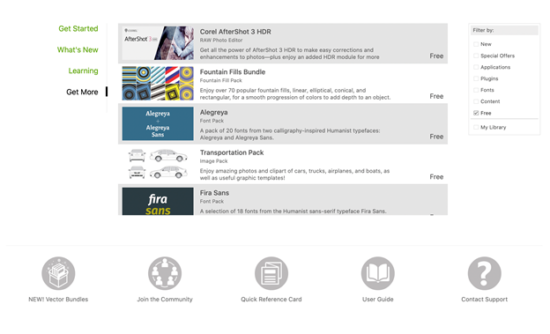CorelDraw has been steadily developing and growing its own distinct user base, gaining strength from its solid footing in the Windows world and adding on Mac support. CorelDraw’s availability with a perpetual license gives Corel a talking point for Mac users who don’t like the idea of subscription. Finally, it goes without saying that CorelDraw is all the more attractive to some users because of the wealth of tools in the box. In addition to the CorelDraw design tool, which competes strongly against Adobe Illustrator, Affinity Designer, and Canvas Design, the suite includes Corel’s Photo-Paint, Font Manager, PowerTrace, and AfterShot 3 HDR. AfterShot is a powerful RAW editor and a valuable add-on for CorelDraw, but it has to be installed separately from the original CorelDraw installation. Look for it in the free category on the opening screen. (Note: there is also a version of AfterShot available for sale for $55 and it competes very credibly with Adobe’s Lightroom Classic.)

Corel is building an environment for technical professionals whose work is primarily based on vector workflows. CorelDraw handles raster and vector content, but the end goal for CorelDraw users tends to be vector content. The company’s user base includes printmakers including large format printing, sign makers, apparel and textiles, blueprints and other data graphics businesses, and the more obvious fields of creative design including illustration, publishing, branding and marketing, and fine art.
Corel has been building out the adjacencies along these product vectors. There is a version of CorelDraw Technical Suite for technical illustration and sits along a continuum of Corel products with CorelCAD. In other words, Corel has been building the technical side of its portfolio of technology and this version of CorelDraw adds strength to the portfolio.
In 2019, CorelDraw returned to the Mac after leaving the field in 2001. With the new release, Corel committed to the Mac and took advantage of the Apple Touch Bar and support for Dark Mode. It also conforms to Apple’s Human Interface Guidelines. As has been documented again and again, non-conformance can be a deal-breaker for many Mac users.
With 2019, Corel took care of the must-dos for Apple users. Now, in 2020, CorelDraw also has gifts to give. With the arrival of Catalina, CorelDraw gets support for Sidecar, which is hands-down one of the most liberating features Apple has given to artists. Sidecar was enabled by Apple with the Catalina update of the macOS. It allows people to use the Apple Pencil and an iPad like they would use a digitizer tablet. It’s something Mac users have wished for since the arrival of the Apple Pencil.
Using Sidecar doesn’t replace tablets like the Wacom tools. Users complain that Sidecar does not deliver the same fine-point resolution they enjoy using the Pencil and iPad directly and also the slippery glass surface of the iPad doesn’t give the same feel of paper that users get from tablets that have a textured surface. However, the Sidecar solution does work and for many users it works considerably better than a mouse for selection objects with an outline, sketching, and drawing.
Speaking of mice, CorelDraw has added new drawing capabilities that make sketching easier for all users. For instance, the LiveSketch tool adds some delay to the sketching process so you can go over a line to get the right curve before the CorelDraw engine converts it to a Bezier curve. It doesn’t make drawing or tracing with a mouse pleasant but it does make it possible. And used with a pen, as God intends, it gives artists the freedom to sketch their way to the line they want and the end result is cleaner.
Another major modernization Corel has brought with the 2019 release is increased collaboration tools. Corel introduced Corel Cloud and CorelDraw.app with the 2019 version release of CorelDraw. Users can subscribe to Corel Cloud and get access to CorelDraw CDR files in the cloud. It’s designed to function something like Google Docs for creative work. Users can post work and send it out for review. So it’s useful for working with clients and getting approval for art work, or working with teams and making design decisions. It works similarly to Google Docs in that people can post work, highlight elements, make comments and ask for input. Users can then share links. Anyone who has a link can access the user’s CorelDraw.app page and see the artwork, comments, questions, etc., and can make the appropriate response. When sharing work, the user can assign rights allowing others to view, review and comment, or approve. So far, however, the CorelDraw.app doesn’t allow editing the actual CDR file. Users can add changes through a layer on top and they can annotate.
Users can create original work in the CorelDraw.app, and to do that, Corel offers templates and tools.
If you’re reading this in the Spring of 2020, it might be occurring to you that the ability to review would come in handy right about now and you’d be right. CorelDraw is offering free subscriptions to the Corel Cloud through May 31st.
PowerTrace is Corel’s super power
In 2020, Corel has beefed up its tracing tool. CorelDraw has always had powerful vectorization capabilities and the company has nurtured it over the years improving it as improvements to processors enabled technological advances. The next turn of the wheel gives us AI and Corel has used it to speed up PowerTrace. Corel has automated artifact removal and upsampling, which help PowerTrace produce smoother edges. Also, Corel says it has used AI to enable the CorelDraw engine to optimize the quality of a bitmap as it’s being traced.
PowerTrace is used heavily in the textiles and apparel industries and in sign making because it can create vector graphics that can be sent to cutting machines. But also, PowerTrace is getting better and better at creating vector images from photographs, which is great for creating stylized images. In their demo, they demonstrate the ability to use CorelDraw’s Color Harmony features to shift the colors in a photo that has been vectorized. Also, once the image has been traced, the color tools can be used to adjust the colors, merge close shades, and assign specific colors such as Pantone colors to ensure color accuracy.
Using AI for artifact removal and upsampling has application throughout CorelDraw, of course, and so and Corel’s engineers have also used AI to extend the options in its art styles

It’s the PowerTrace tool that makes it easy to recreate photos as vector images or create something more stylized. CorelDraw also includes more filters to create stylized effects and they are taking advantage of AI. Over in PhotoPaint, Corel has added a non-destructive workflow to its effects tool portfolio.
Most of the changes in 2020 are improvements to the tools that were already there, but Corel has completely revamped its Font tools to give users much more control over their fonts.
Corel has taken advantage of OpenType in Windows 10 to add variable font support. Users can adjust the look of their fonts using sliders and completely change the look of their fonts by changing the width and weight and other variables depending on what’s including with the font. Once the user is happy with the font variation they’ve created for themselves, they can save it as an object style to reuse it.
Corel has also added support for lists: bulleted and numbered. Yes, that is one of those things that make someone who is used to common text functions say, wait, CorelDraw didn’t have that? But typography is a language that’s spoken differently in many applications, and users are, no doubt, glad to have this functionality, no matter how long it took.
Putting it all together
CorelDraw versions 2019 and 2020 combine as a significant upgrade for an old familiar and comfortable program. It has added support for the Mac and has started moving into the cloud. As of this writing, the CorelDraw subscription is $249 a year and the CorelDraw.app is included. The perpetual license is $499 and CorelDraw.app is available as a paid add on. However, not everyone is going to need the features in CorelDraw.app. The most wonderful thing for many is the ability to get to work from any machine. And, actually that’s another feature Corel is turning on for this season of pandemic—users can have a license of CorelDraw on more than one machine, i.e., the work machine and the home machine.
Corel has done some improvement in performance. The program opens faster than it used to. And with this version, Corel has enabled GPU support for the Mac as well as for Windows machines. As someone who is just returning to CorelDraw from an absence, I can say that it’s still not snappy by any means but wait times are clearly reduced. There is clearly more work to be done under the hood.
As the program has grown and has become more powerful over the years—and it is extraordinarily powerful, especially for its target base of users—it has also become more complex. Its workflow is still more intuitive than in other products but for someone just learning the product’s capabilities, finding added controls hidden in dialogs and inspectors is tricky. I found myself accomplishing some task, by some miracle, and then being unable to do it again because I could not remember where I found the relevant controls. A little committed study and work time will make understanding the tools and their variables easier, but there are users who turn to CorelDraw every now and then for specific features like PowerTrace, or creating technical illustrations, etc. Streamlining the dockers, dialogs, and inspectors would be a blessing.
CorelDraw has a strong case for artists, designers, and crafts people. CorelDraw 2020 will make long time users happy, and it’s got plenty for Mac users looking for a set of professional design tools.
What do we think?
This is a time of opportunity for companies offering creative tools for professionals. Adobe has encircled a good-sized swath of those people, but many have jumped the fence because they don’t want to commit to a subscription. New users might find Adobe’s products too complex and daunting for the price. CorelDraw, with all its included tools, is one lower-priced option. Affinity is another, and we’re seeing Canvas come on strong.
CorelDraw has built up a wealth of webinars and tutorials to make learning the product much easier. It’s Discovery Center puts all the education tools in one place. So, all that can add up to a strong competitive position in a big market.





